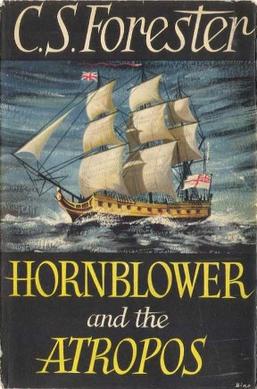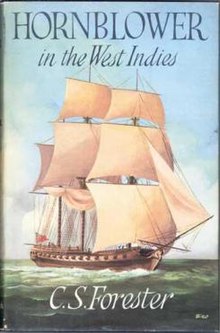
Cecil Louis Troughton Smith, known by his pen name Cecil Scott "C. S." Forester, was an English novelist known for writing tales of naval warfare, such as the 12-book Horatio Hornblower series depicting a Royal Navy officer during the Napoleonic Wars.

Master and Commander is a nautical historical novel by the English author Patrick O'Brian, first published in 1969 in the US and 1970 in the UK. The book proved to be the start of the 20-novel Aubrey–Maturin series, set largely in the era of the Napoleonic Wars, on which O'Brian continued working until his death in 2000.
Horatio Hornblower is a fictional officer in the British Royal Navy during the Napoleonic Wars, the protagonist of a series of novels and stories by C. S. Forester. He later became the subject of films and radio and television programmes, and C. Northcote Parkinson elaborated a "biography" of him, The True Story of Horatio Hornblower.
Dudley Bernard Egerton Pope was a British writer of both nautical fiction and history, most notable for his Lord Ramage series of historical novels. Greatly inspired by C.S. Forester, Pope was one of the most successful authors to explore the genre of nautical fiction, often compared to Patrick O'Brian.

The Happy Return is the first of the Horatio Hornblower novels by C. S. Forester. It was published in 1937. The American title is derived from the expression "beat to quarters", which was the signal to prepare for combat. This book is sixth by internal chronology of the series. Hornblower's past history as described here does not entirely accord with his history as revealed in the stories written later, but Forester never revised the book.

Vice Admiral Cuthbert Collingwood, 1st Baron Collingwood was an admiral of the Royal Navy, notable as a partner with Lord Nelson in several of the British victories of the Napoleonic Wars, and frequently as Nelson's successor in commands.

Captain Horatio Hornblower is a 1951 British naval swashbuckling war film in Technicolor from Warner Bros., produced by Gerry Mitchell, directed by Raoul Walsh, that stars Gregory Peck, Virginia Mayo, Robert Beatty and Terence Morgan.

Sir James Lucas Yeo,, was a British naval commander who served in the War of 1812. Born in Southampton, he joined the Royal Navy at the age of 10 and saw his first action in the Adriatic Sea. He distinguished himself in combat multiple times, most notably during the Portuguese conquest of French Guiana, earning knighthoods in the Portuguese Order of Aviz and the British Order of the Bath. He was given command of the frigate Southampton, in 1812, but his ship was wrecked in the Bahamas although he was acquitted of blame for its loss. Yeo was then given command of the squadron on Lake Ontario and commanded it during several engagements with the Americans.

Mr. Midshipman Hornblower is a 1950 Horatio Hornblower novel written by C. S. Forester. Although it may be considered as the first episode in the Hornblower saga, it was written as a prequel; the first Hornblower novel, The Happy Return, was published in 1937.

Hornblower and the Hotspur is a Horatio Hornblower novel written by C. S. Forester.

The Commodore is a Horatio Hornblower novel written by C. S. Forester. It was published in the United States under the title Commodore Hornblower.

Lord Hornblower is a Horatio Hornblower novel written by C. S. Forester, originally intended to be the last in the series.

Admiral of the Fleet Sir James Alexander Gordon, GCB was a Royal Navy officer. As a volunteer, he fought at the Battle of Groix, at the Battle of the Glorious First of June and at the Battle of Cape St Vincent during the French Revolutionary Wars and then, as a midshipman, served under Admiral Sir Horatio Nelson at the Battle of the Nile.

Hornblower and the Crisis is a 1967 historical novel by C. S. Forester. It forms part of the Horatio Hornblower series, and as a result of Forester's death in 1966, it was left unfinished. There is a one-page summary of the last several chapters of the book found on the final page, taken from notes left behind from the author. It was the eleventh and last book of the series to be published, but it is fourth in chronological sequence.

Hornblower and the Atropos is a 1953 historical novel by C.S. Forester.

A Ship of the Line is an historical seafaring novel by C. S. Forester. It follows his fictional hero Horatio Hornblower during his tour as captain of a ship of the line. By internal chronology, A Ship of the Line, which follows The Happy Return, is the seventh book in the series. However, the book, published in 1938, was the second Hornblower novel completed by Forester. It is one of three Hornblower novels adapted into the 1951 British-American film Captain Horatio Hornblower R.N..
"Hornblower and the Widow McCool" is a short story by C. S. Forester featuring his fictional naval hero Horatio Hornblower. It was first published in the 9 December 1950 issue of The Saturday Evening Post as "Hornblower's Temptation" and then in the UK in the April 1951 Argosy as "Hornblower and the Big Decision." It was published as "Hornblower and the Widow McCool" along with the unfinished novel Hornblower and the Crisis and the short story "The Last Encounter" in 1967, after Forester's death. The story is set after Mr. Midshipman Hornblower and before Lieutenant Hornblower.
"The Last Encounter" is a short story by C. S. Forester which provides the final chapter in the life of his fictional naval hero Horatio Hornblower. It first appeared in the 8 May 1966 Sunday Mirror. The following year it was published together with the unfinished novel Hornblower and the Crisis and another short story, "Hornblower and the Widow McCool".
Alan Lewrie is the fictional hero and main character of Dewey Lambdin's naval adventure series of novels set during the American and the French Revolutions and the Napoleonic Wars. The series spanned some twenty-five novels with a 26th reportedly in progress at the time of Mr. Lambdin's death in July 2021.















